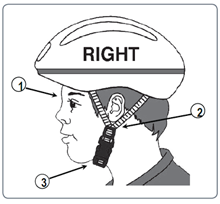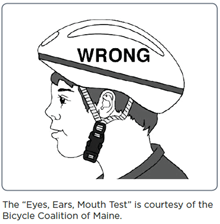Bike and Multi-Sport Helmets: Quick Fit Check
You can download this article as a PDF (Amharic, Arabic, English, Spanish, Tigrinya).
Proper Helmet Fit
Use this easy, 3-point check to test for a proper helmet fit.


1. Eyes
Helmet sits level on your child’s head and rests low on the forehead, 1 to 2 finger widths above the eyebrows. A helmet pushed up too high will not protect the face or head well in a fall or crash.
2. Ears
The straps are even, form a “Y” under each earlobe, and lay flat against the head.
3. Mouth
The buckled chin strap is loose enough so that your child can breathe. There should be enough room so you can insert a finger between the buckle and chin. It should be tight enough that if your child opens their mouth, you can see the helmet pull down on top.
Why are helmets needed?
Helmets provide the best protection against head and brain injury, whether your child is riding a bike, scooter or skateboard, or using skates. However, a helmet will only protect when it fits well. Help your child get in the habit of wearing a helmet by starting when they’re young. Be a good role model and wear a helmet yourself.
How do I choose a helmet?
- Choose a helmet that meets safety standards. For biking, riding a scooter, recreational rollerskating and in-line skating, look for a helmet with a CPSC (Consumer Product Safety Commission) or Snell sticker inside.
- For skateboarding, or aggressive, trick or extreme skating, look for a helmet that has a sticker inside saying it meets ASTM F1492. It is not enough for the helmet just to look like a skate helmet.
- There are some helmets that meet both the CPSC and ASTM F1492 standards. They are multi-sport helmets and can be used for biking, skating, riding a scooter and skateboarding. Don’t be fooled into thinking that helmets that look “skate-style” are always multi-sport. Look for the two safety standard labels to be sure they are dual-certified.
- Helmet costs vary. Expensive helmets are not always better. Choose one that fits properly, and that your child likes and will wear.
- Helmet sizes vary between manufacturers. Always test for proper fit.
- Check used or hand-me-down helmets with care, and never wear a helmet that is cracked or broken. Used helmets may have cracks you cannot see. Older helmets may not meet current safety standards.
What are the pads for?
Helmets come with fit pads to help ensure a proper fit. Use the pads where there is space at the front, back and/or sides of the helmet to get a snug fit. Move pads around to touch your child’s head evenly all the way around. Replace thick pads with thinner ones as your child grows.
How do I check the fit?
If you can move the helmet from side to side, add thicker pads on the sides or adjust the universal fit ring on the back if the helmet has one.
When done, the helmet should feel level, fit solidly on your child’s head and be comfortable. If it doesn’t fit, keep working with the fit pads and straps or try another helmet.
Safety Tips
- Teach your child to take their helmet off before playing at the playground or climbing on equipment or trees. The straps can get caught on poles or branches and prevent your child from breathing.
- Adjust the helmet when wearing a different hair style. When possible, leave hair loose or tie it back at the base of the neck.
- For skiing or snowboarding, you will need another type of helmet.
When does a helmet need to be replaced?
- Bike helmets are good for only 1 crash. Replace the helmet after a crash, and when the manufacturer suggests.
- Follow the instructions from the manufacturer to know when to replace your multi-impact helmet.
- Replace the helmet if it does not have a CPSC, Snell or ASTM sticker inside, it no longer fits, or your child doesn’t like it.
30-second version
Full version
To Learn More
- Seattle Children's Health and Safety Program
- Bicycle Helmet Safety Institute
- Cascade Bicycle Club
- Talk to your child's healthcare provider.